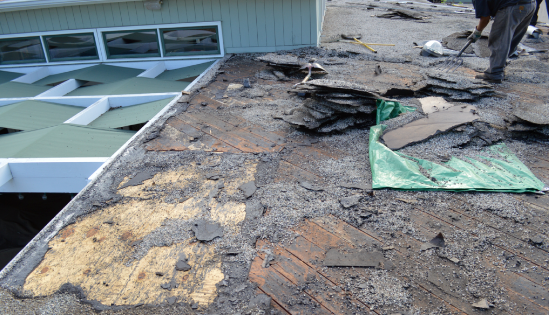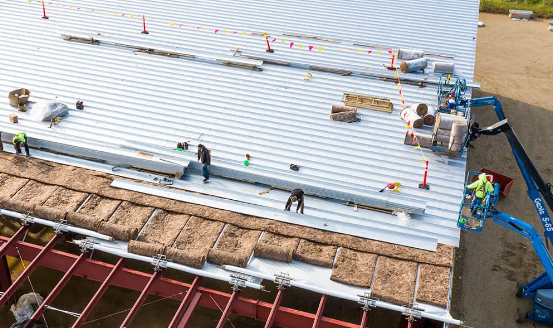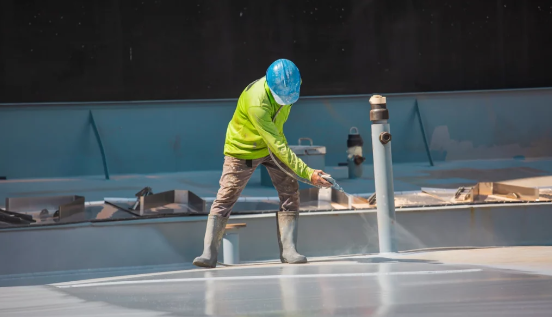Commercial Roofing Repair Process
Proper commercial roofing repairs are essential for the upkeep of roofing systems on commercial properties. These repairs can range from minor tasks, such as sealing leaks, to significant replacements of damaged areas. Timely interventions are crucial to prevent further deterioration, safeguard interior spaces, and ensure the safety of occupants.
Common roofing issues include leaks, punctures, cracks, blistering, pooling water, and membrane shrinkage, often resulting from weather exposure, aging, or improper installation techniques. Identifying the underlying cause is critical for effective repair solutions.
Comet Roofing Contractors conduct comprehensive inspections to evaluate damage and suggest appropriate repair options, which may include patching, sealing, or full material replacement depending on the extent of the issues.
Regular maintenance and swift repairs can prolong the life of a commercial roofing system, reduce costly damages, and protect property value. Commercial property owners should prioritize routine inspections and address any concerns promptly to maintain the integrity of their roofing systems.

Clean Damaged Roof Area
We start by removing debris and dirt from the damaged area and its surroundings to maintain a clean and efficient workspace. Our skilled technicians employ professional-grade blowers and hand tools to clear away loose shingles, granules, and any roofing debris that could hinder adhesion. Once the area is cleared, our team conducts a comprehensive inspection to evaluate the extent of the damage and uncover any underlying issues, carefully scrutinizing flashings, valleys, ridge caps, and the integrity of the membrane.
This thorough assessment enables us to devise the most effective repair strategy, ensuring the damage is properly addressed from the decking up. Our certified roofers will inspect for compromised underlayment, water infiltration beneath the shingles, and possible concerns with the roof's drainage system, including gutters and downspouts.
Our detailed approach guarantees a robust, high-quality repair that reinstates your roof's integrity and safeguards your business. We utilize top-tier materials that are compatible with your existing roofing system, whether it’s EPDM, TPO, built-up roofing (BUR), or architectural shingles.
When repairing penetrations or tackling ponding water issues, we ensure proper slope and sealing to avert future leaks. For commercial flat roofing systems, we confirm that all seams are correctly heat-welded or adhered in line with manufacturer specifications. We pay close attention to the roof's perimeter, parapet walls, and any mechanical equipment curbs to ensure comprehensive waterproofing. Our repairs are engineered to endure UV exposure, thermal cycling, and severe weather conditions, providing enduring protection for your investment.

Damaged Roofing Material Removal
We begin by meticulously removing the compromised roofing materials to reveal the affected area, starting with a detailed tear-off procedure that involves lifting shingles, shakes, or tiles without damaging the underlying decking or felt paper. Our skilled roofers utilize specialized roofing tools, such as spades and pry bars, to guarantee precision during this essential demolition phase.
After clearing the damaged section, we carry out repairs to establish a strong, secure base while addressing any deteriorated roof sheathing, battens, or rafters that may have experienced water damage or rot. We replace any affected plywood decking and assess the structural integrity of all joists and trusses nearby.
Next, we meticulously prepare the area to create a clean and stable foundation for the installation of new roofing materials. This includes applying suitable underlayment, like synthetic felt, ice and water shield, or rubberized membranes, tailored to your roof's requirements and local climate conditions. We ensure the correct installation of drip edges and flashing around all roof penetrations, valleys, and eaves.
Our thorough approach guarantees that the new materials—whether architectural shingles, clay tiles, slate, or metal panels—are seamlessly integrated with proper overlaps, nailing patterns, and ridge ventilation systems. This not only restores the roof’s durability and aesthetic appeal but also provides long-lasting protection against various weather elements, including wind-driven rain, hail impacts, UV degradation, and seasonal temperature fluctuations. The final repair includes appropriate counter-flashing at all wall intersections and chimney perimeters, with careful attention to maintaining optimal attic ventilation ratios and ensuring all penetrations are well-sealed using approved roofing mastic or caulking compounds.

Replacement of New Roofing Material
We expertly install new roofing materials with precision, ensuring they align seamlessly with the existing design and structure of your home. Our experienced team carefully integrates the new materials with the current roofing system, maintaining a consistent appearance and structural integrity. Utilizing high-quality materials and skilled craftsmanship, we rejuvenate your roof to its original aesthetic while bolstering its durability and weather resistance. This meticulous approach guarantees a cohesive and long-lasting solution that effectively safeguards your home.
Prior to any installation, our certified roofers perform a comprehensive inspection of the roof deck, assessing for soft spots, water damage, or deteriorated decking that could undermine your new roofing system's integrity. We take great care in preparing the substrate by removing debris and ensuring adequate ventilation with ridge vents, soffit vents, and attic fans to extend your roof’s lifespan and maximize energy efficiency.
We specialize in a wide range of roofing systems—from architectural shingles and standing seam metal to slate, clay tiles, and TPO membrane systems for flat roofs. Our installation includes premium underlayment equipped with ice and water shield along all eaves, valleys, and penetration points to prevent leaks from ice dams and wind-driven rain. We ensure drip edge flashing is installed around all roof perimeters and apply proper step flashing where the roofing intersects with vertical walls.
Our master craftsmen pay meticulous attention to all penetration flashings around chimneys, skylights, and plumbing vents, using professional-grade sealants and metal counterflashing as necessary. We adhere to strict nailing patterns based on manufacturer specifications to ensure your roofing materials achieve their rated wind resistance, often surpassing local building codes. Each installation concludes with a thorough final inspection, verifying proper shingle alignment, uniform reveals, and clean, straight ridge caps that enhance your home's curb appeal while providing decades of reliable protection.

Replace Roofing Sealant
Effectively sealing all roofing elements is crucial for ensuring a long-lasting and leak-proof roof. Inadequate sealing can allow water to infiltrate weak spots, resulting in leaks, mold proliferation, and structural decay. These problems weaken your roof’s integrity and can lead to expensive repairs. Conducting regular inspections and employing professional sealing techniques can help avert moisture damage, ensuring your roof stays robust and resilient against the elements. Safeguard your business by emphasizing proper sealing for enduring protection and peace of mind.
The overall strength of your roofing system heavily relies on the precise installation of flashing around penetrations, valleys, and eaves. Skilled roofers recognize that combining high-quality underlayment with effective sealants forms a waterproof barrier, shielding the decking from moisture. Additionally, ridge vents and soffit ventilation, when paired with thorough sealing, help maintain ideal attic conditions, thwarting condensation that could jeopardize your shingles and rafters.
When assessing the condition of a roof, seasoned contractors pay close attention to signs of membrane wear, especially along parapet walls and at the drip edge where water runoff is most prevalent. EPDM and TPO membranes require specific sealing methods at the seams to preserve watertight integrity throughout their lifespan. Bituminous materials like modified bitumen and built-up roofing systems must be meticulously checked at lap joints where water intrusion frequently occurs.
In colder climates, ice dam formation can push water under inadequately sealed shingles, making proper starter strip installation and the application of ice-and-water shields essential preventive measures. Counter-flashing must be effectively embedded in masonry and secured with suitable caulking to block moisture from seeping behind the primary flashing. It's important to note that your fascia boards and soffits are key components of your roofing system that necessitate proper sealing to avert water damage to your building envelope.

Final Inspection
A thorough final inspection is carefully carried out by the skilled roofing foreman and essential business stakeholders to verify that all identified damaged areas have been effectively repaired according to industry standards. This collaborative walkthrough allows everyone involved to meticulously examine the completed work, ensure that repairs meet or exceed expectations, and address any outstanding issues prior to project completion. The inspection team diligently inspects the roof deck, shingle alignment, ridge caps, flashing details, and all penetration points to confirm that installation and weatherproofing are executed properly.
Particular focus is placed on critical areas such as valleys, eaves, and chimney flashings, which are prone to water intrusion. The team assesses proper nail placement, adequate underlayment installation, and effective ventilation to ensure the roofing system operates as a unified whole. Ice and water shield barriers are checked in vulnerable zones, while downspouts and gutters are evaluated to confirm proper drainage capacity.
The inspection also validates that all necessary ridge venting is installed correctly to optimize airflow and reduce moisture accumulation in the attic. Drip edges are reviewed to ensure that water effectively sheds away from fascia boards and soffits. Any required counterflashing against adjoining walls is confirmed for secure attachment and proper overlap with step flashing.
This meticulous focus on detail and clear communication between contractors and stakeholders guarantees complete customer satisfaction with the finished roofing project. The comprehensive inspection process ensures that the roof system is fully restored to its optimal condition, structurally sound, properly sealed, and set to provide durable, weather-tight protection for the business property and its valuable assets for years ahead.
Frequently Asked Questions
Got questions about commercial roofing repairs? We’ve got answers! Here are some of the most common inquiries we receive from our clients.
What are the signs that my commercial roof needs repairs?
Look for water stains on ceilings, missing shingles, or visible wear and tear. If you notice any of these signs, it’s time to call us for a professional assessment.How long do commercial roofing repairs take?
The duration of repairs can vary based on the extent of the damage. Minor repairs may take a few hours, while more extensive work could take several days. We’ll provide a timeline during our initial consultation.What types of roofing materials do you work with?
Explore OptionsWe handle a variety of common commercial roofing materials including Single-Ply, Metal, Bitumen, and Built-Up (Tar). Our team can help you choose the best option for your building’s needs.
Do you offer warranties on your repairs?
Yes, we provide warranties on our roofing repairs to ensure your peace of mind. Details will be discussed during your consultation.How can I maintain my commercial roof?
Regular inspections and maintenance are key. Keep gutters clear, check for debris, and schedule professional inspections at least twice a year.
What is the commercial roof repair process?
The commercial roof repair process typically begins with a thorough inspection to assess the damage. After identifying the issues, we’ll provide a detailed estimate and discuss the best repair options. Once approved, our team will schedule the repair work, ensuring minimal disruption to your business operations.Learn MoreHow much does commercial roof repair cost?
Material Average CostsThe cost of commercial roof repair can vary widely based on factors such as the type of roofing material, the extent of the damage, and the complexity of the repair. Lee Island Roofing provides free estimates to give you a clear idea of the costs involved.
Do I need to be present during the repair?
While it’s not necessary for you to be present during the repair, we recommend being available for any questions or decisions that may arise. Our team will communicate with you regularly to keep you updated on the progress.
Need More Help?
If you have more questions or need assistance, don’t hesitate to reach out to us. Our team at Lee Island Roofing is here to help!

